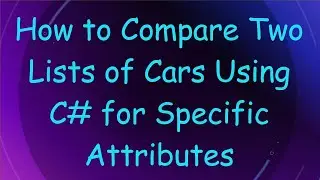Why You Can't Parse JSON from Data Files Using jQuery
Summary: Explore the reasons why parsing JSON from `.json` files using jQuery might not work as expected, and learn how to effectively handle JSON data in your projects.
---
Disclaimer/Disclosure - Portions of this content were created using Generative AI tools, which may result in inaccuracies or misleading information in the video. Please keep this in mind before making any decisions or taking any actions based on the content. If you have any concerns, don't hesitate to leave a comment. Thanks.
---
Parsing JSON data is an essential part of many web development projects. JSON (JavaScript Object Notation) is widely used due to its simplicity and the ease with which it can be parsed and generated. However, users often encounter issues when trying to parse JSON from external files using jQuery. Let's explore some common reasons why parsing might not work and how you can troubleshoot and resolve these problems effectively.
Understanding JSON and jQuery
JSON is a lightweight data interchange format that is language-independent but uses conventions that are familiar to programmers of the C family of languages. jQuery, on the other hand, is a fast, small, and feature-rich JavaScript library. It makes things like HTML document traversal and manipulation, event handling, and animation much simpler with an easy-to-use API that works across a multitude of browsers.
jQuery supports parsing JSON directly via the $.getJSON() method, which loads JSON-encoded data from the server using a GET HTTP request. Despite the simplicity of usage, users may sometimes struggle with parsing JSON from files.
Common Issues and Solutions
Cross-Origin Resource Sharing (CORS) Problems:
Issue: If your web page is hosted on a different domain than your data.json file, your request might be blocked by CORS policies.
Solution: Ensure that your server is configured to handle CORS correctly. You can do this by setting appropriate headers (Access-Control-Allow-Origin) on your server.
Local File Access Restrictions:
Issue: If you try to serve your HTML page and data.json file locally (like using file:// instead of a web server), browsers often block these requests for security reasons.
Solution: Use a local server to serve your files. Tools like Node.js, Python's SimpleHTTPServer, or dedicated software like XAMPP can help.
Incorrect File Path:
Issue: A common mistake is providing an incorrect path to your JSON file.
Solution: Double-check the file path to ensure it's correct relative to your HTML file.
Parse Errors Due to Invalid JSON:
Issue: If your JSON file contains syntax errors, parsing will fail.
Solution: Validate your JSON file using online validators or tools to ensure it is correctly formatted.
Caching Issues:
Issue: Sometimes the browser caches the JSON file, and jQuery might not be fetching the latest version.
Solution: Disable caching for your JSON requests by appending a timestamp or a unique query string to the request URL.
Best Practices
Use Fetch API: Consider using the Fetch API for more modern and flexible ways to handle HTTP requests. It naturally supports Promises and allows more robust error handling.
JSON.parse: Combine the jQuery $.get() with JSON.parse for manual parsing when needed.
Environment Setup: Always test your application in an environment that closely resembles your production setup to avoid surprises due to differing configurations or restrictions.
By understanding these issues and solutions, jQuery users can better handle JSON parsing from external files, leading to smoother application development and deployment. Always remember, proper configuration and validation are key to successful JSON data handling.































